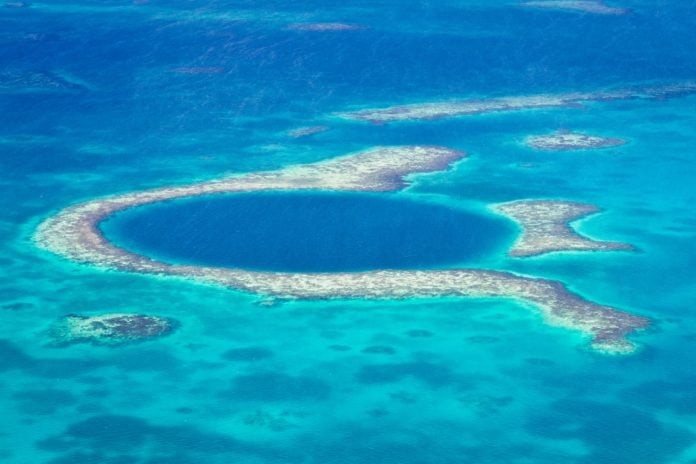There’s a rainbow breaking through the overcast tropical clouds as dawn breaks 80km from the coast of Caye Caulker, a small island in the Caribbean Sea.
I’m in Belize and I’m here for one reason: the Great Blue Hole. Lying near the center of the world famous Lighthouse Atoll, this diving icon is the largest submarine sinkhole on earth.
Its measurements on paper alone are impressive enough – spanning a whopping 300m across and more than 124m deep – but laying eyes on this behemoth takes it to a whole new level.
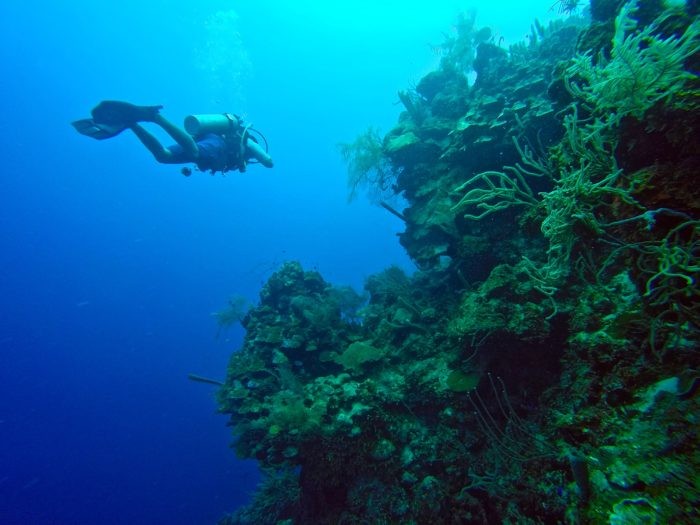
Entering through the break in the reef, just as Jacques Cousteau did all those years ago, the blue hole’s geological formation is clearly visible from the top deck of the Maera, the flagship of Belize Diving Services (BDS). Admittedly it’s not as clear as it would be from the air – as seen in all the postcards – but nonetheless, it is still uniquely identifiable.
A total of 12 of us have made the two and a half hour journey from super laid-back Caye Caulker. Despite the BDS crew’s flawless navigation and stomach-lining cooked breakfast, it’s been somewhat of a bumpy ride due to unseasonable rain. However, once within the protected waters of the reef, all of us have the opportunity to contemplate the fact that we are about to tick off a dive which features near the very top of most divers’ bucket lists.
Submerging first to a 12m shelf, a sandy slope leads down towards the hole itself. There’s no abundance of marine life here (which may come as a surprise to anyone who has dived elsewhere in Belize) but that’s not the point of this site. Instead, this is a dive that is all about the earth’s natural geologic design. Any marine life is a bonus.
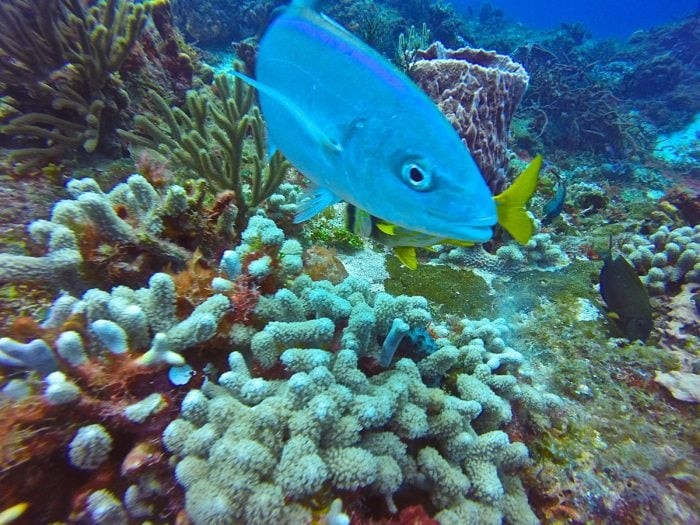
16m down and the dive is already mesmerizing. The deep abyss of blue is truer than any I’ve seen before, heightened no doubt by a lack of light. Descending deeper still, it seems any light that does break through is immediately absorbed by the limestone.
The limestone itself is the only reference amidst the ever darkening blue, though it’s at this depth that there’s the best chance to see Caribbean and black tip reef sharks which will cruise past.
Soon after is when the first enormous stalactites appear, forming a cathedral-like cavern which caves downwards to 40m – the dive’s max depth. Circling back past these limestone chandeliers, we start to ascend and, as with any deep dive, it’s over all too quickly. Thankfully we have the second and third dives of the day to look forward to.
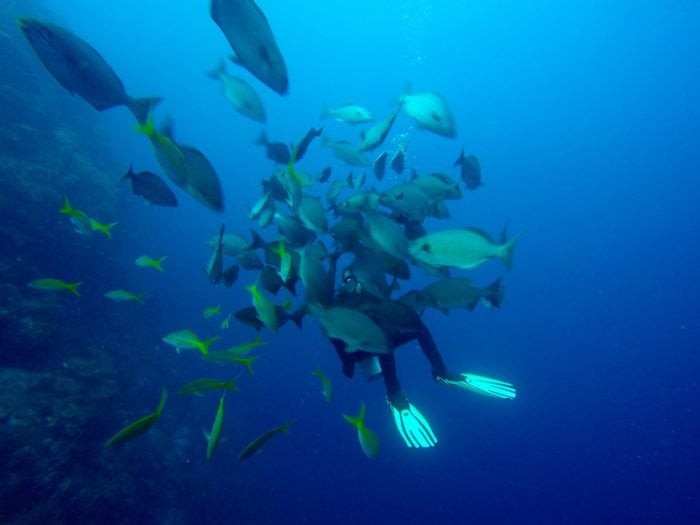
Though known most famous for the UNESCO World Heritage protected Blue Hole, the whole Belize Barrier Reef, the northern hemisphere’s largest, is ripe with virgin, untouched coral.
BDS General Manager CJ Graham, a Canadian expat who has been living and diving in Belize for the past eight years, explains the reef’s magnitude.
“It’s near on impossible to estimate how many dive sites we have here,” he says. “I’d guess there are more than 60 that are commonly accessible by divers but we’re talking about a reef that is 300km long and stretches almost the entire length of the country.”
Established in 1978 as the first dive operator on the island, BDS is the leading facility in Caye Caulker. As part of their marquee blue hole trip, the 5 Star SDI Instructor Training Facility includes dives at Half Moon Caye and Long Caye, both of which are found at the diver renowned Lighthouse Atoll.
Talking with BDS’ divemasters and instructors, it’s apparent that these sites are almost everyone’s favorites and it’s immediately clear what all the fuss is about. The coral at Half Moon is as healthy as any other on the globe, but arguably, it’s bettered by that at Long Caye.
Dives at Half Moon and Long Caye include swim through’s, vast coral gardens and huge schools of fish – including inquisitive Bermuda Chub that will follow divers’ bubbles for most of the dive. Caribbean reef sharks are common in these waters and dive groups tend to spot at least a handful. However, curious black tips and the occasional hammerhead can sometimes be seen along with spotted eagle rays, the occasional manta and nurse sharks.
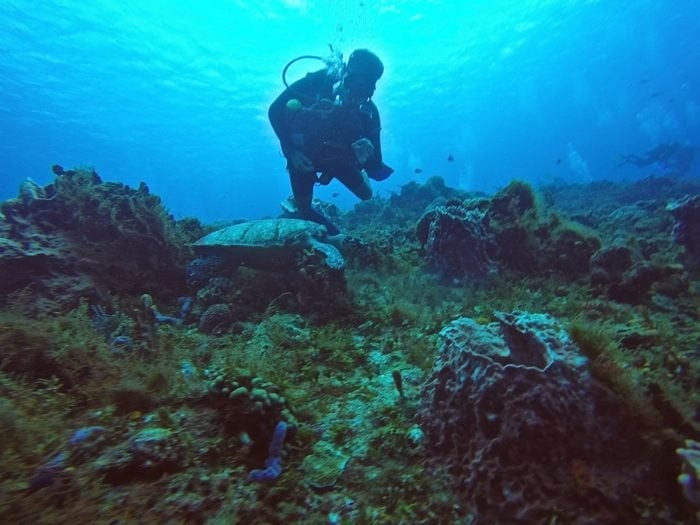
The site at Long Caye is aptly named ‘Aquarium’ thanks to the hoards of reef fish that have made this their perfect choice for a home. Barracuda and tarpon stalk the reef here but it’s the sheer beauty of the coral – along with unrivaled visibility that can typically reach 50m in summer months – that steals the show, putting these sites up there with our planet’s very best.
However, along with world-class coral (other closer-to-shore sites to keep divers busy include those around San Pedro and the protected marine reserve, Hol Chan), Caye Caulker is also slowly establishing itself as a new frontier for cave diving.
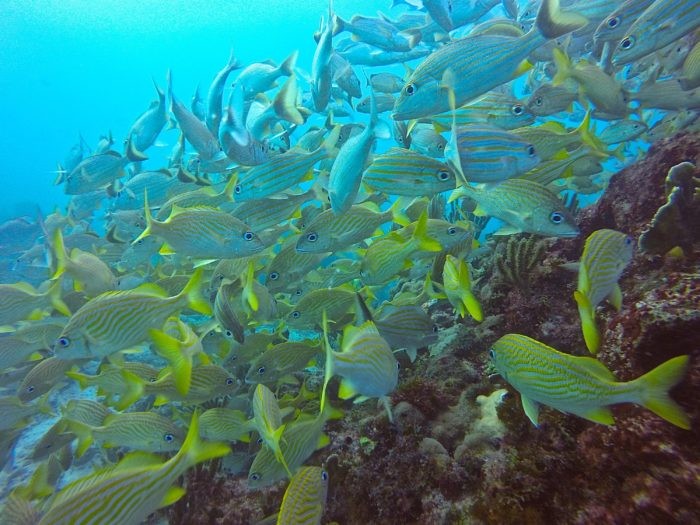
Within the last few years, exploration of two underwater caves has begun and estimations suggest they could both be amongst the world’s biggest and deepest. Understandably, BDS has been working hard to ready them for recreational access and now also holds rebreather training courses specifically with the caves in mind.
Between its caves, world class reefs, spectacular atolls and, of course, the Great Blue Hole, the question has to be asked, is there a better dive location anywhere on earth than Belize? I’m certainly not willing to answer that, but would suggest you head there to make up your own mind.
What You Need to Know
How to Get There
Belize isn’t cheap to get to so it’s worth exploring the option of flying in from neighboring Mexico if you’re not adverse to a stopover. Frequent flights go from Cancun, as well as various other cities in Central and North America. Like direct international flights, they land in Belize City from where Caye Caulker is just a short ferry hop.
Caye Caulker itself is tiny – there aren’t even any cars, just golf carts – so finding your way around the island itself is easy. Then its just a case of jumping in and enjoying the diving…
When to Go
High season runs from mid-December to April when the drier weather makes the cayes ideal for soaking up the sun and diving alike. Diving year round is possible but those willing to brave the heat and heavy rains during May to November are rewarded with well-priced flights and cheaper accommodations. Be warned though, some dive shops, hotels and restaurants close for September / October when the low season is at its, well, lowest.
Currency
The Belize dollar parallels its US counterpart, always at a 2:1 ration on the inter-bank exchange. US dollars are accepted everywhere also.
Where to Eat
Whilst neighboring Ambergis Caye caters for the well-healed traveler, Caye Caulker is a little more low-key. Backpackers and those on a budget will delight at the fact that it’s still possible to eat a whole lobster at one of the island’s countless eateries for around US$10. However, those looking to splash out a bit more will be treated to seafood feasts as good as any other in Latin America.
Restaurants range from humble, family run beach grills to the much more gourmet, though you certainly won’t find any silver service here. Pick of the bunch is Habaneros, where the portions are as creative as they are tasty.
For a no frills option that’s off the beaten track, seek out Elvis’. The owner-come-chef cooks up sublime feasts outside his home until the day’s deliciously fresh produce is gone. You’ll need to get there early to avoid missing out.
Where to Dive
Ask anyone where to dive in Belize and most will only give one answer: Belize Diving Services. Initially set up in 1978 as the first dive operator on the island of Caye Caulker, Belize Diving Services has gone from strength to strength under the careful guidance of Canadian manager CJ Graham and owner James ‘Chip’ Peterson.
So high is the bar that BDS sets that its competitors need a stepladder just to try and touch it – and even then most don’t even come close. Make no mistake, this is a dive operator of the very highest quality – perhaps the best I’ve ever seen.

